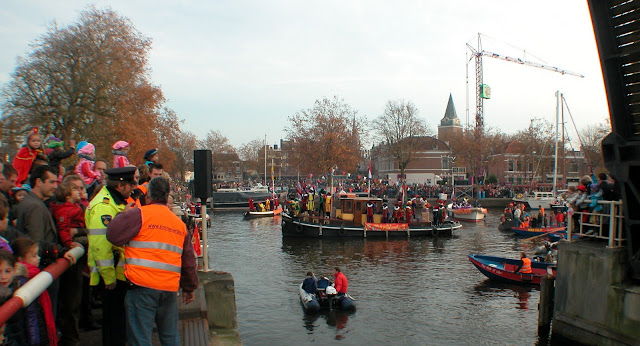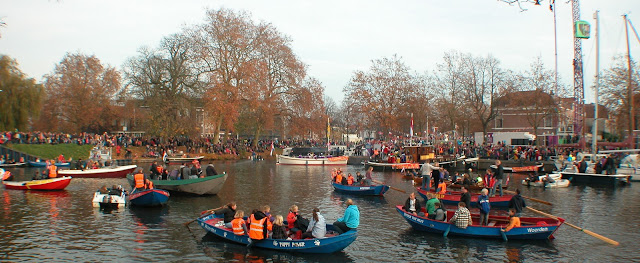With Love Henk & Wenona
Lake Calhoun is the biggest lake in Minneapolis, Minnesota, and part of the city's Chain of Lakes. Surrounded by city park land and circled by bike and walking trails, it is popular for many outdoor activities. The lake has an area of 401 acres (1.62 km2) and a maximum depth of 87 feet (27 m). It is also home for Keelboat Sailing lessons, hosting the Calhoun Yacht Club and the Calhoun Sailing School. The lake is popular for sailing races, canoeing, kayaking and windsurfing.
Wednesday, November 23, 2011
Sunday, November 13, 2011
The story of Sinterklaas and his 2011 arrival in our city Woerden, Holland.
The Dutch has their very own tradition in December, Sinterklaas. This man should not be mistaken for Santa Claus even if they do have kind of the same job. Sinterklaas does not come from the North Pole and he does not have reindeers, brownies or a red cap with a tuft. Sinterklaas lives in Spain and he has a white horse. Instead of the brownies he has Zwarte Pieten, Black Piets, who assist him on his journey, little helpers with dark skin and colourful clothes.
They all board a ship sailing from Spain to a port (different every year) in the Netherlands and when arriving, they are welcomed by the mayor and citizens. They arrive sometime in mid November just in time for the annual parade which is the start of the “Sinterklaas season”. The following weeks are spent to the assessment of the behavior of the children during the past year. In short, if they have been naughty or nice. He keeps this information in a large leather bound book, with gold print. They get to sit on his lap and then he asks them about their behavior during the year. And you can not lie to Sinterklaas, can you? That is why naughty children go straight into the sack and have to go back to Spain with Sinterklaas.
The eve of December 5th is a special day for all Dutch children. This is when Sinterklaas rides around the country on his white horse. Children put shoes under the chimney and they also place a piece of carrot in them as a reward for the horse. Sinterklaas stops at the roof of the houses and send a Piet down the chimney to put some kind of gift in the shoes. This is often a piece of chocolate in the form of the receiver's first initial and pepernoten, small hard cookies. This is a very busy time for Sinterklaas, in the day he visits schools and other places and in the evening people's homes. He knocks on the door and hand out gifts from his sack.
Of course he needs a bit help sometimes, so kind souls dress up in a red cape with golden embroidery over white clothes, fix themselves a nice white beard and put a mitre-shaped red hat with a golden cross on their heads and grab a golden shepherd’s staff to go with that. These clothes are much similar to the ones worn by bishops. This because the model of Sinterklaas is said to have been Saint Nicholas, a bishop from Myra in Turkey born in 271 AD.
There are numerous legends about his good deeds. One story is that he saved three little girls from being sold by their poor father. By throwing three golden pieces for their dowry through the window he saved them from a future in despair. It just happen to be that the gifts landed in the stockings that the girls had hung up by the fireplace to dry. Another story say that he brought three children back to life after they had been chopped up by a butcher.
He just put the pieces together and prayed and suddenly they were alive without a scratch. He is also the patron saint of the sailors after calming a storm at sea and when doing that he saved the lives of many people, including himself. Old scripts say that Saint Nicholas died on the 6th of December in 343 AD, that is why he is remembered this time a year. His relics have been the subject of some disagreements, but they are said to be in Bari in Italy since 1087.
Saint Nicholas connection to shipping might explain why Sinterklaas is said to live in Spain. In the 17th century the Netherlands was a major shipping nation and the country had close connections with Spain. This would also explain the dark colour of the skin of the Zwarte Pieten, since Spain naturally gets more sun than northern Europe. Another explanation for it could be the constant climbing up and down sooty chimneys.
The celebration of Sinterklaas is foremost for children and families, but some friends also celebrate with giving each other gifts. Short humorous rhymes or poems are attached to the gifts and they often have a personal touch. There are a number of popular songs about Sinterklaas and the stories surrounding him. Special food that is close connected to the celebration are Speculaas, a spiced cake filled with almond paste. Marzipan is another appreciated goodie.
On Christmas, the 25th and 26th of December, Santa Claus visit some families and bring gifts. Others just do not care for the American fellow and all the fuss around him. Which is actually quite ironic since it was the Dutch people themselves that brought him along when they settled in New Amsterdam (present-day New York) in the 17th century.
Happy Sinterklaas on Dec 5th
Subscribe to:
Posts (Atom)










